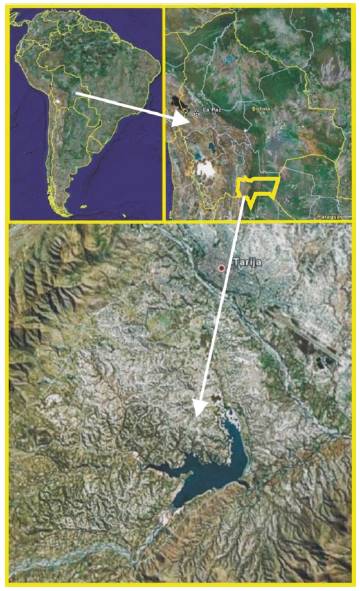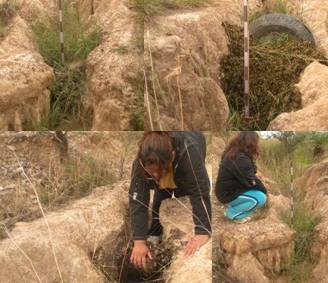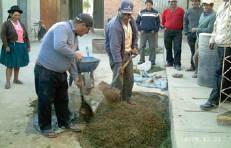
Teaching and demonstrating azolla projects in Bolivia
The following text and illustrations were kindly provided by Azolla Foundation Associate François Laviolette, who can be contacted at francoispatty@hotmail.com
 During the past few years, we have used azolla in a variety of ways in the region of Tarija, southern Bolivia, where Azolla filiculoides is native.
During the past few years, we have used azolla in a variety of ways in the region of Tarija, southern Bolivia, where Azolla filiculoides is native.
This potential is enabled by azolla’s rapid growth, as we have attained a high rate of azolla production (over 300 grams / square meter / day of fresh matter), with the resulting azolla containing approximately 25% of proteins.
In addition to the traditional uses of azolla as a livestock feed (fodder) and organic fertilizer, we have implemented a variety of programs that have significantly improved rural development and agricultural practices in the Tarija region of southern Bolivia.
These are briefly described below.
Mitigation of erosion
 Azolla has significant potential in mitigating erosion by providing a method to ‘naturally’ fill in diverse erosion holes (ravines or gullies) that result from rainfall runoff. The addition of azolla to these erosion holes creates an organic-rich clayey soil, which is not longer susceptible to erosion, and in which seeds and plants can develop very rapidly, leading to a natural progressive development of the soil.
Azolla has significant potential in mitigating erosion by providing a method to ‘naturally’ fill in diverse erosion holes (ravines or gullies) that result from rainfall runoff. The addition of azolla to these erosion holes creates an organic-rich clayey soil, which is not longer susceptible to erosion, and in which seeds and plants can develop very rapidly, leading to a natural progressive development of the soil.
If the ravine is too high or too wide to support the azolla biomass, it may be necessary to drive some branches of local trees into the soil next to and immediately downstream from the “azolla dam” to prevent the azolla from being washed away.
After two or three rainfall episodes, some ravines behind the azolla dams were completely refilled with sediments that were washed in by the rain. These were then rapidly covered with grass or other plants, which generally could not germinate without an azolla biomass because of the very dry and hard mineralized soil.
A similar project is being undertaken in the Congo, West Africa, where fresh azolla layers are being successfully used to protect small irrigation dykes (‘ditches’) constructed of clay. The rainfall force and run-off impact were strongly reduced using azolla than with other types of protection, such as a concrete-clay mix, which are often much more expensive than using azolla.
Water purification
In southern Bolivia, azolla is used to purify water, resulting in reduced levels of nitrogen and phosphorus from chemical fertilizers, plus pesticides and toxic heavy metals.
The figure below shows azolla being introduced into a water treatment plant, after azolla successfully eliminating water pollution and unpleasant smells.
Reduced evaporation of water
Azolla is used to reduce evaporation from water bodies such as natural and artificial ponds and lakes. In Tarija, southern Bolivia, warm winds and high temperatures rapidly dry bodies of water and reduce water levels by more than 1.5 cm/day. This is solely due evaporation, because no water loss occurs through downwards infiltration due to the pure clay substrate.
Ponds in which azolla covers the entire surface, and from which azolla was slowly harvested, maintain a clean, fresh water source that is better for irrigation. Due to the azolla cover, some ponds maintain water all year, in contrast to ponds without azolla that often lose all of their water due to evaporation.
Biodiversity and azolla
In semi-deserts, such as those of southern Bolivia close to Tarija, azolla promotes and hosts numerous species of insects and animals, including ants, beetles, freshwater molluscs, and aquatic worms such as chironomids). This creates a significant ecological niche, plus food for freshwater fish that may also be present. In contrast, ponds without azolla have much lower aquatic biodiversity, except in those cases where azolla covered all of the pond, reducing the amount of light and hence the species biodiversity.
Other uses
Azolla has several other potential uses in southern Bolivia, which need further investigation to confirm their potential:

Making and using azolla mulch between rows of vegetables
[1] A thick mulch of azolla maintains the soil humidity for 2 or 3 weeks longer than soils that do not have the mulch. This could have a significant positive impact for reforestation projects.

making bocachi in Bolivia
[2] Azolla rapidly produces a high-quality organic fertilizer, which is called bocachi (aka bocashi, bokashi) in Bolivia. Within one week, mixing 10 large bags of fresh azolla with 3 large bags of dung (from goat or sheep) and 1 large bag of organic soil, some baking powder and sugar wastes (with a little water) creates a superb compost that is immediately ready to use.
[3] Azolla can be used as ‘mechanical herbicide’ by putting thick layers of fresh azolla between rows of vegetable. This prevents weeds from germinating and growing.
[4] Azolla prevents the predation of freshwater fish by some birds, which are afraid of diving in ponds partly covered with azolla. This increases fish production.
[5] In dry locations where it is important to slow the drying of wet concrete, an azolla layer applied as a mulch prevents the concrete from drying too quickly. This helps the concrete to set without the need continuously wet it.
[6] Dried azolla can be used as a source of energy biogas or fuel.
[7] Dried azolla can be used as construction blocks for small buildings.
[8] Azolla can be used as a substrate for the production of small amounts of edible fungi.
